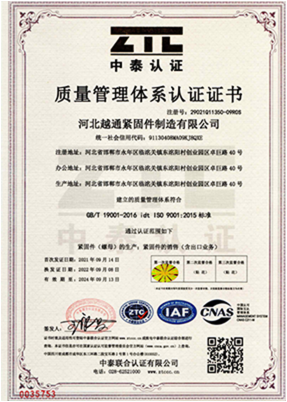12월 . 22, 2024 17:00 Back to list
screw thread types
Types of Screw Threads A Comprehensive Overview
Screw threads are essential components in mechanical engineering, used to convert rotational motion into linear motion and to fasten objects together. The variety of screw thread types, each with unique characteristics, serves specific purposes across various applications in engineering, manufacturing, and construction. Understanding these different thread types is crucial for selecting the right one for a particular use.
1. Unified Thread Standard (UTS)
The Unified Thread Standard is prevalent in the United States and Canada. It includes both inch-based and metric threads. UTS threads are designated by the number of threads per inch (TPI) and the diameter in inches. Common examples include the UNC (Unified National Coarse) and UNF (Unified National Fine). The coarse thread is primarily used for general-purpose applications, while the fine thread is preferred for higher tensile strength and finer adjustments.
2. Metric Threads
Metric threads conform to the International Organization for Standardization (ISO) standards and are expressed in millimeters. The pitch is defined as the distance between the threads, and metric thread sizes are represented in the format of MxP, where M indicates the thread diameter in millimeters and P the pitch. For example, M10x1.5 indicates a 10 mm diameter with a 1.5 mm pitch. Metric threads are widely adopted in Europe and are increasingly utilized globally, especially in automotive and machinery sectors.
3. Acme Threads
Acme threads are characterized by their trapezoidal shape, allowing for greater load capacity and smoother movement. They are primarily used in machinery for applications such as lead screws and linear motion systems. Acme threads provide excellent resistance to wear, can handle heavy loads, and reduce friction, making them suitable for applications requiring precise positioning.
Similar to Acme threads, square threads feature a square cross-section. They are designed for high efficiency in power transmission and are used in applications such as vises and jacks. The square thread form minimizes friction between interfaces, enhancing overall efficiency and load-bearing capabilities. However, the production of square threads is more complex and often more expensive compared to other types.
screw thread types

5. Whitworth Threads
Invented by Sir Joseph Whitworth in the 19th century, Whitworth threads feature a rounded profile and are typically used in piping and plumbing applications. The threads are standardized in terms of pitch, form, and angle, making them versatile for various joints and fittings.
6. BSW and BSP Threads
British Standard Whitworth (BSW) and British Standard Pipe (BSP) threads are two other prominent types originating from the UK. BSW threads are similar to Whitworth but are adapted for more specific engineering applications. BSP threads, on the other hand, are specifically designed for use in plumbing and hydraulic systems, featuring a specific angle between threads (55 degrees) and ensuring a watertight seal.
7. Standard Thread Profiles
Several standard thread profiles exist to accommodate different needs. These profiles include - Coarse Threads Used for rapid assembly applications where strength is not the primary concern. - Fine Threads Provide improved mechanical advantage and tighter adjustments, often used in precision instruments. - Left-Hand Threads Designed to tighten counterclockwise, they are used in situations where standard threads might loosen by the direction of rotation.
8. Applications of Thread Types
The application of various screw thread types spans across numerous industries, including aerospace, automotive, construction, and manufacturing. Each thread type plays a critical role in ensuring durability, load capacity, and ease of assembly. For instance, UTS and metric threads are commonly found in automotive fasteners, whereas specialized threads like Acme and square threads are often seen in machinery requiring linear motion.
Conclusion
In conclusion, the world of screw thread types is vast and varied, with each type tailored for specific performance requirements and applications. Understanding these distinctions helps engineers and manufacturers select the appropriate thread type for their projects, ensuring functionality and reliability in mechanical systems. As technology advances, new thread designs may continue to emerge, enhancing the capabilities and efficiencies of threaded fasteners in the ever-evolving landscape of engineering.


